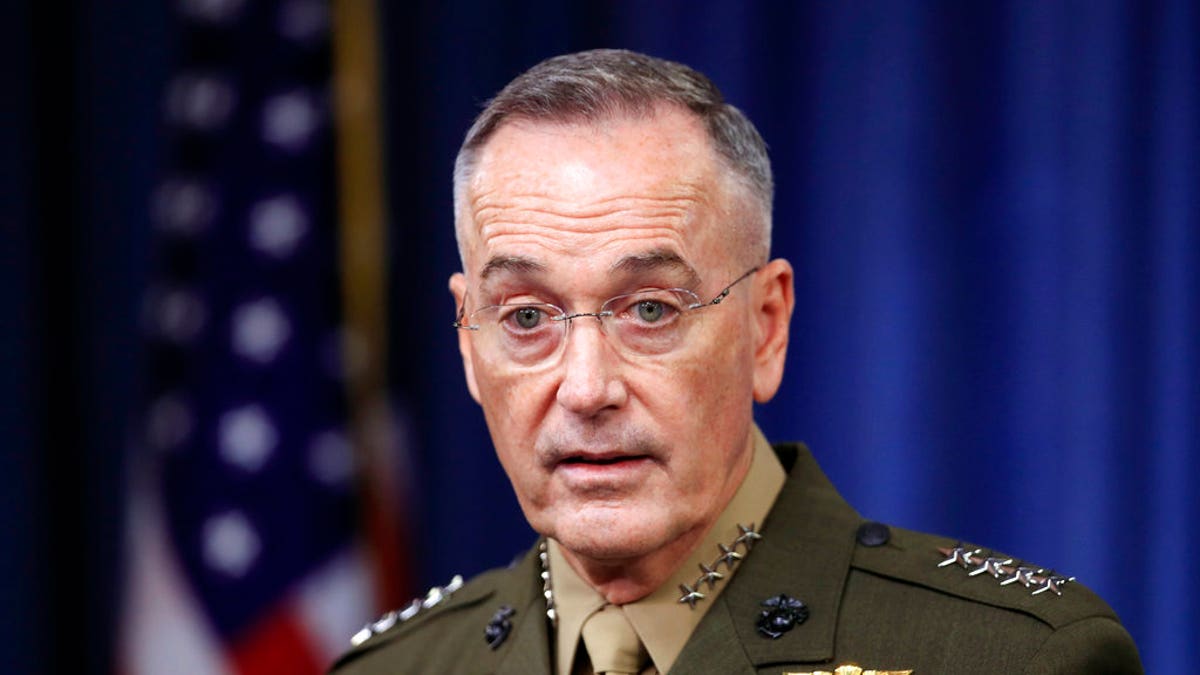
Joint Chiefs Chairman Gen. Joseph Dunford said the fall of Raqqa represents “an inflection point, it's not the end of the campaign.” (AP Photo/Manuel Balce Ceneta, File)
The U.S. troops ambushed in Niger earlier this month may have been betrayed by a local villager, U.S. military officials say.
Pentagon officials believe the local Nigerien may have tipped off attackers to the presence of U.S. commandoes and Nigerien forces in the area, setting the stage for the ambush that killed four Americans, a senior defense official said Tuesday.
The official said the Army Green Berets and about 30 Niger forces stopped in a village for an hour or two to get food and water after conducting an overnight reconnaissance mission. After they left, they were ambushed by about 50 heavily armed enemy fighters, who also killed four Niger fighters and wounded two Americans and several Nigerien troops.
Marine Gen. Joseph Dunford, chairman of the Joint Chiefs of Staff, told reporters Monday that small numbers of Islamic State insurgents have been trying to recruit local fighters in places like Niger.
Those fighters often rebrand themselves as IS. But Dunford said the U.S. has not seen any significant numbers of IS insurgents outside of Iraq and Syria.
Meanwhile, U.S. efforts against terrorism are likely to focus more on Africa now that the Islamic State group has been forced out of Raqqa, Syria, its de facto capital, the Christian Science Monitor reported.
In the wake of the Niger ambush, even senior lawmakers in Washington seemed unaware of the size of the U.S. presence in Niger and surrounding African nations, the newspaper reported.
“I didn’t know there was a thousand troops in Niger,” U.S. Sen. Lindsey Graham, R-S.C., said Sunday during an appearance on NBC’s “Meet the Press.” Graham is a member of the Senate Armed Services Committee.
Details about the Oct. 4 attack in Niger, and the events leading up to it, have been murky, trickling out over the last three weeks.
According to the official, the joint U.S. and Niger patrol was asked to help a second American commando team that had been hunting for a senior member of al-Qaida in the Islamic Maghreb believed to be in the area.

The four U.S. service members killed Oct. 4 in Niger were, from left, U.S. Army Special Forces Sgt. Jeremiah Johnson; U.S. Special Forces Sgt. Bryan Black; U.S. Special Forces Sgt. Dustin Wright; and U.S. Special Forces Sgt. La David Johnson (Reuters)
The official wasn't authorized to discuss the incident publicly so spoke on condition of anonymity.
The joint U.S. and Niger team was initially sent on a routine mission to meet local tribal leaders and work with the Niger forces. But after they had set out on Oct. 3, they received a new assignment, the official said. They were asked to go to a location where the insurgent had last been seen, and collect intelligence.
Because the insurgent was no longer in that area, military commanders believed the operation wasn't risky, the official said, adding there was no order to search for or find the AQIM member.
Under the rules, U.S. troops in Niger can accompany local forces on missions when "the chances of enemy contact are unlikely." The official said the decision to change the joint team's mission may have met those rules because the AQIM insurgent was no longer there, but those are some of the questions the ongoing investigations will answer.
U.S. military officials believe the intelligence mission went well during the night. But on their way back to their base in the morning, the U.S. and Niger troops stopped at a village about 50 miles north of Niger's capital, Niamey.
After getting supplies and meeting with tribal leaders, the joint patrol left the village. It is at that point, the official said, that the U.S. believes someone in the village alerted the IS-linked militants that American and Niger forces were in the area.
The joint team was attacked about 120 miles north of Niamey, by what officials believe was a relatively new offshoot of the Islamic State group that calls itself Islamic State in the Sahel. That group is not believed to be connected to the AQIM leader that the other American special forces team has been looking for.
The enemy fighters attacked on motorcycles, carrying rocket-propelled grenades and heavy machine guns, setting off a long and complex battle.
Dunford said the U.S. special forces unit didn't call for help until an hour into their first contact with the enemy. And he acknowledged that many questions linger about the assault.
Those questions, said the defense official, will include who authorized the decision to change the team's mission, as well as why it took so long to evacuate the wounded and why one of the killed U.S. soldiers was missing for two days before his body was recovered.
Asked Tuesday about the decision to give the team another mission, Dunford declined to provide any details, saying those are the questions the investigation will answer. He added that once the investigation is complete, U.S. military officials will first meet with the families of the fallen soldiers and tell them what happened, then release the information publicly.
The Associated Press contributed to this story.




















